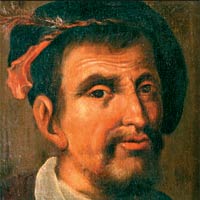 The one-day workshop on ‘The Biblioteca Hernandina and the Early Modern Book World’, held at the Parker Library at Corpus Christi College, Cambridge on Tuesday, was a richly stimulating event. Organised by Edward Wilson-Lee and José María Pérez Fernández, the workshop convened a group of experts to discuss aspects of the enormous library of Hernando Colón, son of Christopher Columbus, who after some early journeying with his father in the New World devoted much of his life to travelling in search of books.
The one-day workshop on ‘The Biblioteca Hernandina and the Early Modern Book World’, held at the Parker Library at Corpus Christi College, Cambridge on Tuesday, was a richly stimulating event. Organised by Edward Wilson-Lee and José María Pérez Fernández, the workshop convened a group of experts to discuss aspects of the enormous library of Hernando Colón, son of Christopher Columbus, who after some early journeying with his father in the New World devoted much of his life to travelling in search of books.
José María and Edward kicked things off by offering a potted biography of Colón and an account of his life in book-buying. His shopping expeditions began in Spain in 1510, moved on to Italy in 1512, and subsequently took him to Germany, France, the Netherlands and England. He also sent agents out to extend his collections, instructing them to focus on cheaper and more unusual small-format books rather than buying the kind of expensive folios that could be obtained anywhere. Along the way he paid visits to heroes such as Erasmus, taking care to receive at least one book as a gift on each visit, and he may have befriended Albrecht Durer, whose works he added to his vast collection of printed woodcuts and engravings. The result was a library that dwarfed other collections of the day, boasting more than 15,000 titles. A number of catalogues witness his struggle not merely to list the books he owned, but also to render them useful. Rather than letting the books die on the shelves, he sought to release their contents through a massive project of indexing and epitomizing–a project that was doomed to failure, and which was left unfinished at his death in 1539.
One of the most striking features of Hernando’s collecting was his enthusiasm for ephemera, and in the morning session Miguel Martínez explored his penchant for broadside ballads, newsbooks and controversial pamphlets–the sort of cheap publications that would have flooded the streets of his native Seville. Despite their former ubiquity, such items now survive in single copies if they survive at all, and they no longer extant in Cólon’s library as it survives in Seville Cathedral. Andrew Pettegree picked up this topic of lost books, suggesting that as many as two-thirds of all early modern editions may have disappeared without trace. He explained how the editors of the Universal Short Title Catalogue are using a variety of archival records to infer the existence of lost editions–10,000 of them so far–which are being added to the catalogue to create a much fuller map of pre-1600 print culture. The third paper in this session focused on a particular book, Christopher Columbus’s copy of Marco Polo’s account of China. Ana Carolina Hosne reconsidered the question of how far Columbus was aware of Polo’s work when he set out to pioneer a westward route to Cathay–given that his copy in the Biblioteca Hernandina post-dates his second expedition of 1498.
The afternoon session began with Tess Knighton on Cólon’s music books. As well as setting Cólon in relation to other Spanish collectors, Knighton’s talk challenged the idea that all of Cólon’s music-buying would have required foreign travel. Although it is clear that some of his shopping for the earliest printed polyphonic music was done in Italy, the mobility of books in the period was such that a range of international publications would have been on sale in Seville. Alexander Marr took on the subject of prints, exploring the curious blind-spots in Cólon’s massive collection of woodcut and intaglio images and asking whether these point us to his personal tastes, or merely to the financial constraints imposed by someone who seems to have watched every maravedí as he trawled the seas of ink. Vittoria Feola concluded the session by considering the fate of the Hernandina library in relation to other great collections, including the library of Elias Ashmole, which she is currently cataloguing. Her account of the unpredictable twists and turns of books-as-property suggested that there are many ways in which a library can be ‘lost’. The most perfectly preserved collection can be unknown and unused, kept in a gilded cage with no catalogue to guide readers to its contents.
The conference closed with a round-table discussion which started out from a fascinating memoir of Cólon by his servant Juan Pérez, and which moved on to attempt to integrate the day’s findings. Was Cólon a bad collector, someone who put quantity above quality and whose cataloguing techniques were little better than quixotic? What should we make of his buying of books in languages he couldn’t read and that he considered ‘barbaric’ (such as his large collection of German Lutheran pamphlets)? And what sense can we make of his ephemeral collecting? Does his investment in the popular mark him out as exceptional, or does our propensity to find it surprising merely reveal the distortions in our view of the period?
You can read more about the project, and see some photos from books in Cólon’s collections, here.